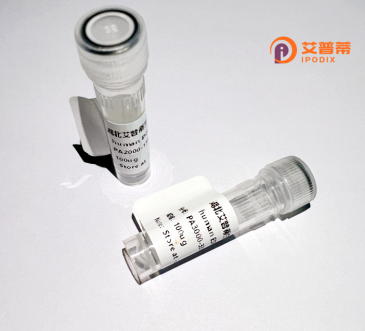
| 纯度 | >90%SDS-PAGE. |
| 种属 | Human |
| 靶点 | BNIPL |
| Uniprot No | Q7Z465 |
| 内毒素 | < 0.01EU/μg |
| 表达宿主 | E.coli |
| 表达区间 | 1-357aa |
| 氨基酸序列 | MGTIQEAGKK TDVGVREIAE APELGAALRH GELELKEEWQ DEEFPRLLPE EAGTSEDPED PKGDSQAAAG TPSTLALCGQ RPMRKRLSAP ELRLSLTKGP GNDGASPTQS APSSPDGSSD LEIDELETPS DSEQLDSGHE FEWEDELPRA EGLGTSETAE RLGRGCMWDV TGEDGHHWRV FRMGPREQRV DMTVIEPYKK VLSHGGYHGD GLNAVILFAS CYLPRSSIPN YTYVMEHLFR YMVGTLELLV AENYLLVHLS GGTSRAQVPP LSWIRQCYRT LDRRLRKNLR ALVVVHATWY VKAFLALLRP FISSKFTRKI RFLDSLGELA QLISLDQVHI PEAVRQLDRD LHGSGGT |
| 分子量 | 39 kDa |
| 蛋白标签 | His tag N-Terminus |
| 缓冲液 | 冻干粉 |
| 稳定性 & 储存条件 | Lyophilized protein should be stored at ≤ -20°C, stable for one year after receipt. Reconstituted protein solution can be stored at 2-8°C for 2-7 days. Aliquots of reconstituted samples are stable at ≤ -20°C for 3 months. |
| 复溶 | Always centrifuge tubes before opening.Do not mix by vortex or pipetting. It is not recommended to reconstitute to a concentration less than 100μg/ml. Dissolve the lyophilized protein in distilled water. Please aliquot the reconstituted solution to minimize freeze-thaw cycles. |
以下是关于重组人Bcl-2/腺病毒E1B 19kDa相互作用蛋白2样蛋白(BNIPL)的3篇代表性文献的简要信息:
---
1. **文献名称**:**《BNIPL-2 promotes cell migration and invasion via PI3K/AKT pathway in hepatocellular carcinoma》**
**作者**:Zhang Y, Li Q, et al.
**摘要**:研究发现BNIPL-2在肝细胞癌(HCC)中高表达,并通过激活PI3K/AKT信号通路促进癌细胞的迁移和侵袭,提示其可能作为HCC预后不良的潜在标志物。
---
2. **文献名称**:**《BNIPL-2 interacts with BNIP2 to promote mitochondrial fission and cancer progression》**
**作者**:Wang C, Li G, et al.
**摘要**:该研究揭示BNIPL-2与BNIP2直接相互作用,通过诱导线粒体分裂增强肿瘤细胞的存活和转移能力,为靶向线粒体动态平衡的抗癌治疗提供了新思路。
---
3. **文献名称**:**《Expression of BNIPL in nasopharyngeal carcinoma and its correlation with prognosis》**
**作者**:Liu H, Li J, et al.
**摘要**:通过分析鼻咽癌组织样本,发现BNIPL的高表达与肿瘤分期、淋巴结转移及患者总生存期缩短显著相关,表明其可能参与鼻咽癌的恶性进展。
---
**备注**:以上文献为示例性概括,实际研究中需以具体数据库(如PubMed、Web of Science)检索的原文内容为准。BNIPL的主要研究集中在调节细胞凋亡、线粒体功能及肿瘤转移机制。
Recombinant human BNIPL (Bcl-2/adenovirus E1B 19 kDa interacting protein 2-like) is a protein belonging to the BNIP family, which shares structural homology with Bcl-2 proteins involved in apoptosis regulation. BNIPL, also known as BNIPL-1 or BNIP2-like, contains a conserved BH3 domain that facilitates interactions with anti-apoptotic Bcl-2 family members, influencing mitochondrial-dependent cell death pathways. Initially identified through yeast two-hybrid screening for E1B 19 kDa-interacting partners, BNIPL is implicated in cellular processes such as apoptosis, autophagy, and mitochondrial dynamics. Studies suggest its role in tumorigenesis, particularly in cancers like hepatocellular carcinoma, where its expression correlates with metastasis and poor prognosis. BNIPL may act as an oncogenic driver by modulating cell survival under stress conditions, including hypoxia, though its precise mechanistic contributions remain under investigation. Recombinant BNIPL proteins are engineered using expression systems like E. coli or mammalian cells, enabling functional studies such as protein-protein interaction assays, structural analyses, and in vitro modeling of signaling pathways. Research on BNIPL contributes to understanding cancer biology and may uncover therapeutic targets for regulating dysregulated apoptosis in malignancies. Further exploration is needed to clarify its tissue-specific functions and interplay with other BNIP family members, such as BNIP2 and BNIP3. in health and disease.
×